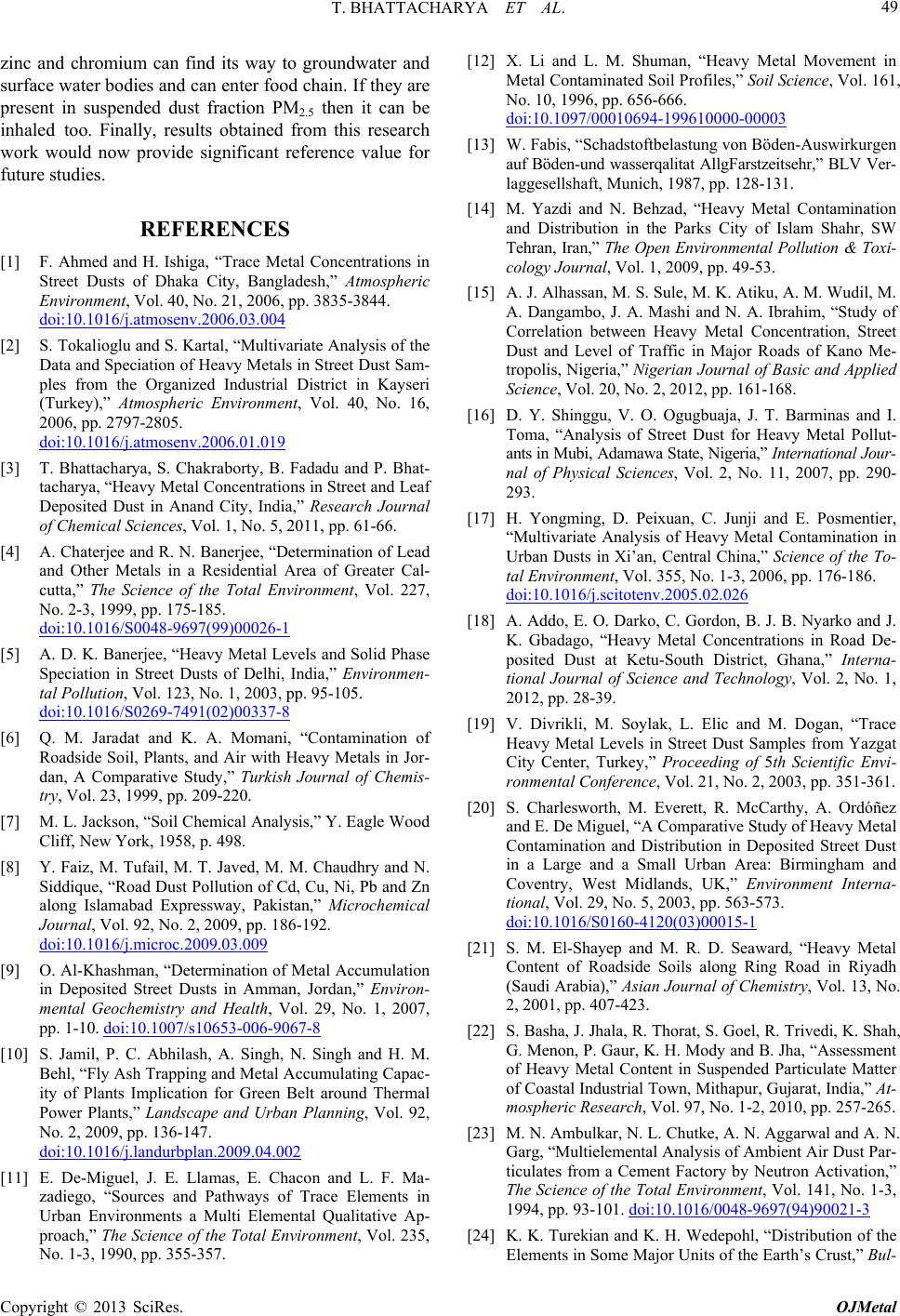
T. BHATTACHARYA ET AL. 49
zinc and chromium can find its way to groundwater and
surface water bodies and can enter food chain. If they are
present in suspended dust fraction PM2.5 then it can be
inhaled too. Finally, results obtained from this research
work would now provide significant reference value for
future studies.
REFERENCES
[1] F. Ahmed and H. Ishiga, “Trace Metal Concentrations in
Street Dusts of Dhaka City, Bangladesh,” Atmospheric
Environment, Vol. 40, No. 21, 2006, pp. 3835-3844.
doi:10.1016/j.atmosenv.2006.03.004
[2] S. Tokalioglu and S. Kartal, “Multivariate Analysis of the
Data and Speciation of Heavy Metals in Street Dust Sam-
ples from the Organized Industrial District in Kayseri
(Turkey),” Atmospheric Environment, Vol. 40, No. 16,
2006, pp. 2797-2805.
doi:10.1016/j.atmosenv.2006.01.019
[3] T. Bhattacharya, S. Chakraborty, B. Fadadu and P. Bhat-
tacharya, “Heavy Metal Concentrations in Street and Leaf
Deposited Dust in Anand City, India,” Research Journal
of Chemical Sciences, Vol. 1, No. 5, 2011, pp. 61-66.
[4] A. Chaterjee and R. N. Banerjee, “Determination of Lead
and Other Metals in a Residential Area of Greater Cal-
cutta,” The Science of the Total Environment, Vol. 227,
No. 2-3, 1999, pp. 175-185.
doi:10.1016/S0048-9697(99)00026-1
[5] A. D. K. Banerjee, “Heavy Metal Levels and Solid Phase
Speciation in Street Dusts of Delhi, India,” Environmen-
tal Pollution, Vol. 123, No. 1, 2003, pp. 95-105.
doi:10.1016/S0269-7491(02)00337-8
[6] Q. M. Jaradat and K. A. Momani, “Contamination of
Roadside Soil, Plants, and Air with Heavy Metals in Jor-
dan, A Comparative Study,” Turkish Journal of Chemis-
try, Vol. 23, 1999, pp. 209-220.
[7] M. L. Jackson, “Soil Chemical Analysis,” Y. Eagle Wood
Cliff, New York, 1958, p. 498.
[8] Y. Faiz, M. Tufail, M. T. Javed, M. M. Chaudhry and N.
Siddique, “Road Dust Pollution of Cd, Cu, Ni, Pb and Zn
along Islamabad Expressway, Pakistan,” Microchemical
Journal, Vol. 92, No. 2, 2009, pp. 186-192.
doi:10.1016/j.microc.2009.03.009
[9] O. Al-Khashman, “Determination of Metal Accumulation
in Deposited Street Dusts in Amman, Jordan,” Environ-
mental Geochemistry and Health, Vol. 29, No. 1, 2007,
pp. 1-10. doi:10.1007/s10653-006-9067-8
[10] S. Jamil, P. C. Abhilash, A. Singh, N. Singh and H. M.
Behl, “Fly Ash Trapping and Metal Accumulating Capac-
ity of Plants Implication for Green Belt around Thermal
Power Plants,” Landscape and Urban Planning, Vol. 92,
No. 2, 2009, pp. 136-147.
doi:10.1016/j.landurbplan.2009.04.002
[11] E. De-Miguel, J. E. Llamas, E. Chacon and L. F. Ma-
zadiego, “Sources and Pathways of Trace Elements in
Urban Environments a Multi Elemental Qualitative Ap-
proach,” The Science of the Total Environment, Vol. 235,
No. 1-3, 1990, pp. 355-357.
[12] X. Li and L. M. Shuman, “Heavy Metal Movement in
Metal Contaminated Soil Profiles,” Soil Science, Vol. 161,
No. 10, 1996, pp. 656-666.
doi:10.1097/00010694-199610000-00003
[13] W. Fabis, “Schadstoftbelastung von Böden-Auswirkurgen
auf Böden-und wasserqalitat AllgFarstzeitsehr,” BLV Ver-
laggesellshaft, Munich, 1987, pp. 128-131.
[14] M. Yazdi and N. Behzad, “Heavy Metal Contamination
and Distribution in the Parks City of Islam Shahr, SW
Tehran, Iran,” The Open Environmental Pollution & Toxi-
cology Journal, Vol. 1, 2009, pp. 49-53.
[15] A. J. Alhassan, M. S. Sule, M. K. Atiku, A. M. Wudil, M.
A. Dangambo, J. A. Mashi and N. A. Ibrahim, “Study of
Correlation between Heavy Metal Concentration, Street
Dust and Level of Traffic in Major Roads of Kano Me-
tropolis, Nigeria,” Nigerian Journal of Basic and Applied
Science, Vol. 20, No. 2, 2012, pp. 161-168.
[16] D. Y. Shinggu, V. O. Ogugbuaja, J. T. Barminas and I.
Toma, “Analysis of Street Dust for Heavy Metal Pollut-
ants in Mubi, Adamawa State, Nigeria,” International Jour-
nal of Physical Sciences, Vol. 2, No. 11, 2007, pp. 290-
293.
[17] H. Yongming, D. Peixuan, C. Junji and E. Posmentier,
“Multivariate Analysis of Heavy Metal Contamination in
Urban Dusts in Xi’an, Central China,” Science of the To-
tal Environment, Vol. 355, No. 1-3, 2006, pp. 176-186.
doi:10.1016/j.scitotenv.2005.02.026
[18] A. Addo, E. O. Darko, C. Gordon, B. J. B. Nyarko and J.
K. Gbadago, “Heavy Metal Concentrations in Road De-
posited Dust at Ketu-South District, Ghana,” Interna-
tional Journal of Science and Technology, Vol. 2, No. 1,
2012, pp. 28-39.
[19] V. Divrikli, M. Soylak, L. Elic and M. Dogan, “Trace
Heavy Metal Levels in Street Dust Samples from Yazgat
City Center, Turkey,” Proceeding of 5th Scientific Envi-
ronmental Conference, Vol. 21, No. 2, 2003, pp. 351-361.
[20] S. Charlesworth, M. Everett, R. McCarthy, A. Ordόñez
and E. De Miguel, “A Comparative Study of Heavy Metal
Contamination and Distribution in Deposited Street Dust
in a Large and a Small Urban Area: Birmingham and
Coventry, West Midlands, UK,” Environment Interna-
tional, Vol. 29, No. 5, 2003, pp. 563-573.
doi:10.1016/S0160-4120(03)00015-1
[21] S. M. El-Shayep and M. R. D. Seaward, “Heavy Metal
Content of Roadside Soils along Ring Road in Riyadh
(Saudi Arabia),” Asian Journal of Chemistry, Vol. 13, No.
2, 2001, pp. 407-423.
[22] S. Basha, J. Jhala, R. Thorat, S. Goel, R. Trivedi, K. Shah,
G. Menon, P. Gaur, K. H. Mody and B. Jha, “Assessment
of Heavy Metal Content in Suspended Particulate Matter
of Coastal Industrial Town, Mithapur, Gujarat, India,” At-
mospheric Research, Vol. 97, No. 1-2, 2010, pp. 257-265.
[23] M. N. Ambulkar, N. L. Chutke, A. N. Aggarwal and A. N.
Garg, “Multielemental Analysis of Ambient Air Dust Par-
ticulates from a Cement Factory by Neutron Activation,”
The Science of the Total Environment, Vol. 141, No. 1-3,
1994, pp. 93-101. doi:10.1016/0048-9697(94)90021-3
[24] K. K. Turekian and K. H. Wedepohl, “Distribution of the
Elements in Some Major Units of the Earth’s Crust,” Bul-
Copyright © 2013 SciRes. OJMetal